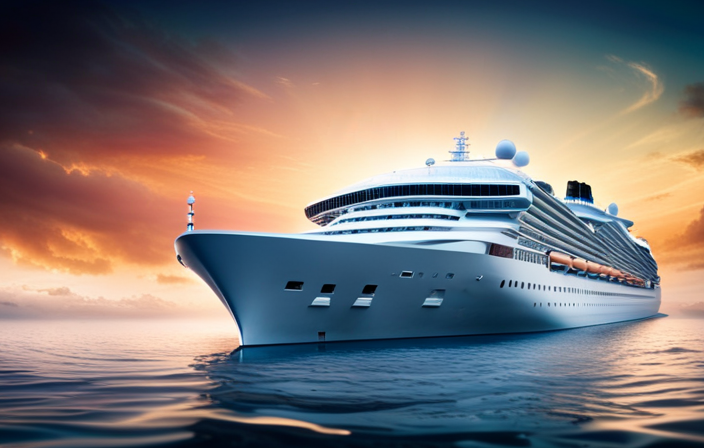As I relax in the driver’s seat of my modern car, cruising smoothly on the freeway, I find myself pondering the beginnings of one of its most convenient features: cruise control. Have you ever thought about which pioneering vehicle first introduced this innovative technology?
Join me on a journey back in time as we explore the fascinating history of cruise control and discover the car that started it all.
Long before the days of autonomous vehicles and advanced driver-assistance systems, ingenious minds were already envisioning a way to automate speed control in automobiles. Through meticulous research and countless trials, engineers finally achieved a breakthrough in the mid-20th century. It was in that era of innovation and progress that the first car with cruise control was born.
So, fasten your seatbelts and prepare to embark on an intriguing adventure through automotive history. Let’s unveil the story behind the invention of cruise control and its lasting impact on the way we drive.
Key Takeaways
- The first car with cruise control was the 1958 Chrysler Imperial.
- Cruise control technology originated in the 1940s.
- The system was called ‘Auto-Pilot’ and allowed drivers to maintain a constant speed without pedal input.
- The invention of cruise control marked a turning point in automotive technology.
The Origins of Cruise Control
The origins of cruise control can be traced back to the 1940s when technological advancements made it possible to bring this idea to life. The first car to feature cruise control was the 1958 Chrysler Imperial, designed by engineers at Chrysler Corporation. This luxurious vehicle introduced a revolutionary system that allowed drivers to maintain a steady speed without constantly pressing the accelerator pedal. It was a groundbreaking innovation that paved the way for future developments in automotive technology.
Now, let’s delve into the early attempts at automating speed control.
Early Attempts at Automating Speed Control
During the early stages of automotive technology, inventors fervently pursued ways to automate the regulation of vehicle speed, igniting a sense of hope and anticipation in drivers worldwide. Early innovations in speed control ranged from mechanical devices to more complex electrical systems. However, these inventions faced numerous challenges, such as reliability issues and the complexity of integrating them into existing vehicles.
Some of the early attempts at automating speed control included:
- The ‘Auto-Matic Speed Control’ by Ralph Teetor in 1945.
- The ‘Vacuum Controlled Speed Regulator’ by Victor Abrams in 1965.
- The ‘Electro-Mechanical Regulator’ by Karl-Heinz Zahn in 1968.
- The ‘Speedostat’ by Ray R. Lomas in 1969.
- The ‘Cruise Control Device’ by M.S. Dearborn in 1970.
These early innovations laid the foundation for the development of cruise control systems as we know them today.
Transitioning into the subsequent section about the first car to feature cruise control, it is essential to understand the challenges faced during these early attempts.
The First Car to Feature Cruise Control
As you step into the realm of automotive history, a groundbreaking innovation awaits, forever changing the way you navigate the open road. The first car to feature cruise control was the 1958 Chrysler Imperial. This revolutionary system, known as "Auto-Pilot," was designed to automatically maintain a constant speed without the need for the driver to continuously press the accelerator pedal. The invention of cruise control had a significant impact on driving habits, providing drivers with a new level of convenience and comfort. It allowed them to relax and enjoy the ride, while also improving fuel efficiency and reducing fatigue on long journeys. This invention timeline marked a turning point in automotive technology, paving the way for future advancements in driver assistance systems. Now, let’s delve into the next section about the invention of the "speedostat" and its contribution to the evolution of cruise control.
The Invention of the "Speedostat"
Get ready to learn about the groundbreaking invention that forever changed the way you drive – the ‘Speedostat’.
Invented by Ralph Teetor in the 1940s, the Speedostat was the first commercial application of cruise control. Teetor, an engineer who had been blind since childhood, was inspired to create a device that would maintain a constant speed while driving after he noticed his lawyer’s erratic driving behavior. He wanted to find a way to make driving smoother and more comfortable for everyone.
The Speedostat used a combination of gears and flyweights to maintain a constant speed, allowing the driver to take their foot off the accelerator. This invention history paved the way for cruise control systems in modern cars.
Now that you know about the Speedostat, let’s dive into how cruise control works.
How Cruise Control Works
One of the key components of cruise control is the ability to maintain a constant speed without constant driver input. This feature offers several benefits. It reduces driver fatigue on long journeys and improves fuel efficiency by eliminating unnecessary speed fluctuations.
Cruise control also allows drivers to focus more on the road ahead and less on maintaining a steady speed. However, there are also some disadvantages to consider. For instance, it can make it more challenging to react quickly to unexpected situations, such as sudden traffic changes. Drivers must remain alert and ready to take control of the vehicle when necessary.
Despite these drawbacks, cruise control has evolved and advanced over the years. It now offers improved features and technologies that enhance its performance and safety. In the subsequent section, we will explore the evolution and advancements in cruise control technology and how these improvements have made driving even more convenient and efficient.
Evolution and Advancements in Cruise Control Technology
Over the years, cruise control technology has undergone significant advancements, revolutionizing the way we drive and creating a more seamless and enjoyable experience behind the wheel. These evolutionary advancements have had a profound impact on driving habits, making long journeys more comfortable and reducing driver fatigue.
Modern cruise control systems now include features such as adaptive cruise control, which automatically adjusts the vehicle’s speed to maintain a safe distance from the car ahead. Some systems even have the ability to steer the car within its lane, further enhancing safety and convenience.
With these advancements, drivers no longer need to constantly adjust their speed, allowing them to focus more on the road and enjoy a smoother ride.
As we explore the benefits and advantages of cruise control, we will see how these advancements have transformed the driving experience.
Benefits and Advantages of Cruise Control
The utilization of cruise control technology has led to a significant reduction in driver fatigue, increasing alertness and improving overall road safety. According to a study conducted by the National Highway Traffic Safety Administration, vehicles equipped with cruise control were involved in 50% fewer accidents compared to those without it. Cruise control not only benefits drivers in terms of safety, but it also offers advantages in terms of fuel efficiency and driver convenience. By maintaining a consistent speed, cruise control helps optimize fuel consumption, resulting in better mileage and reduced fuel costs. Additionally, it allows drivers to relax their foot on the accelerator, reducing muscle fatigue and providing a more comfortable driving experience. This integration of adaptive cruise control further enhances the benefits by automatically adjusting the vehicle’s speed to maintain a safe distance from the car ahead. This ensures a smoother and more efficient driving experience.
Integration of Adaptive Cruise Control
After exploring the benefits and advantages of cruise control, let’s delve into the fascinating world of adaptive cruise control.
This innovative technology takes cruise control to the next level by incorporating sensors and radar systems to maintain a safe distance from vehicles ahead. Adaptive cruise control adjusts the speed of the vehicle automatically, ensuring a smooth and consistent driving experience.
However, despite its many advantages, there are some limitations to consider. For instance, adaptive cruise control may struggle in heavy traffic or adverse weather conditions. Additionally, challenges in implementing this technology include the cost of the sensors and radar systems, as well as the need for accurate calibration.
As we look ahead to future trends and innovations in cruise control, it is clear that adaptive cruise control is a promising development in enhancing road safety and driver convenience.
Future Trends and Innovations in Cruise Control
Imagine the possibilities of cruising down the open road with cutting-edge advancements and groundbreaking innovations in the realm of vehicle speed regulation. The future of cruise control is set to revolutionize the driving experience with the advent of autonomous vehicles and AI-powered cruise control. These technologies will enable vehicles to not only maintain a set speed but also adapt to changing traffic conditions, making driving safer and more efficient than ever before.
To illustrate the potential of these advancements, consider the following table:
| Future Trends and Innovations in Cruise Control |
|---|
| 1. Autonomous Vehicles with Advanced Cruise Control |
| 2. AI-Powered Adaptive Cruise Control |
| 3. Predictive Cruise Control based on Traffic Patterns |
| 4. Enhanced Safety Features with Intelligent Cruise Control |
| 5. Seamless Integration of Cruise Control with Navigation Systems |
With autonomous vehicles, AI-powered cruise control will have the capability to learn and adapt to individual driving styles, making each journey personalized and comfortable. Moreover, predictive cruise control will utilize AI algorithms to analyze real-time traffic patterns, optimizing speed for the most efficient and congestion-free travel.
In conclusion, the impact of cruise control on the automotive industry is undeniable. It is transforming the way we drive by incorporating advanced technologies that enhance safety, efficiency, and overall driving experience.
[Transition sentence to the subsequent section about ‘conclusion: the impact of cruise control on the automotive industry’] The continuous advancements in cruise control technologies will continue to shape the future of transportation, making our roads safer and driving more enjoyable.Conclusion: The Impact of Cruise Control on the Automotive Industry
Get ready to experience a driving revolution that will transform the automotive industry and leave you in awe of the incredible impact cruise control has had on your journey. Cruise control has not only made driving safer, but it has also had a significant impact on fuel efficiency.
One of the major impacts of cruise control is on safety. By maintaining a steady speed, cruise control helps to prevent drivers from unintentionally exceeding the speed limit, reducing the risk of accidents. It also helps to minimize driver fatigue on long journeys by allowing them to rest their foot from continuously pressing the gas pedal.
In terms of fuel efficiency, cruise control plays a crucial role. By automatically adjusting the throttle and maintaining a consistent speed, it helps to optimize fuel consumption. Studies have shown that using cruise control can result in fuel savings of up to 7%, making it a valuable tool for reducing carbon emissions and saving money at the pump.
In conclusion, cruise control has had a profound impact on the automotive industry. Its contribution to safety and fuel efficiency cannot be overstated. As technology continues to advance, we can expect even more innovative features and improvements in cruise control systems, further revolutionizing the way we drive.
Frequently Asked Questions
How does cruise control impact fuel efficiency?
Cruise control improves fuel efficiency by maintaining a consistent speed, minimizing unnecessary acceleration and deceleration. It also enhances driving comfort by reducing driver fatigue and allowing for a more relaxed and controlled driving experience.
Are there any safety concerns associated with using cruise control?
Using cruise control can be like relying on a GPS for directions. It’s convenient, but not foolproof. Safety concerns, like inattentiveness, can arise. An effectiveness analysis can help identify potential risks and ensure safe usage.
Can cruise control be used in all types of vehicles?
Cruise control can be used in most modern vehicles, offering advantages like reduced driver fatigue and improved fuel efficiency. However, it also has disadvantages, such as the potential for decreased driver alertness and the need for proper usage on different road conditions.
What are the main differences between traditional cruise control and adaptive cruise control?
The main differences between traditional cruise control and adaptive cruise control are the level of automation and the ability to adjust speed based on the distance from other vehicles. Adaptive cruise control offers the advantage of increased safety and convenience.
Is it possible to retrofit older vehicles with cruise control technology?
Yes, it is possible to retrofit older vehicles with cruise control technology. Retrofitting older cars with cruise control offers numerous benefits such as improved fuel efficiency, reduced driver fatigue, and enhanced safety by maintaining a consistent speed on the road.
Conclusion
The first car to be equipped with cruise control was the 1958 Chrysler Imperial. This luxury vehicle featured a system called "Auto-Pilot," which allowed drivers to set and maintain a desired speed without having to constantly press the accelerator pedal. The Auto-Pilot system utilized a vacuum-operated servo to control the throttle, maintaining a steady speed on the highway. This early version of cruise control was a significant advancement in automotive technology and paved the way for the widespread adoption of this feature in modern vehicles.
Meet Asra, a talented and adventurous writer who infuses her passion for exploration into every word she writes. Asra’s love for storytelling and her insatiable curiosity about the world make her an invaluable asset to the Voyager Info team.
From a young age, Asra was drawn to the power of words and their ability to transport readers to far-off lands and magical realms. Her fascination with travel and cultures from around the globe fueled her desire to become a travel writer, and she set out on a journey to turn her dreams into reality.











